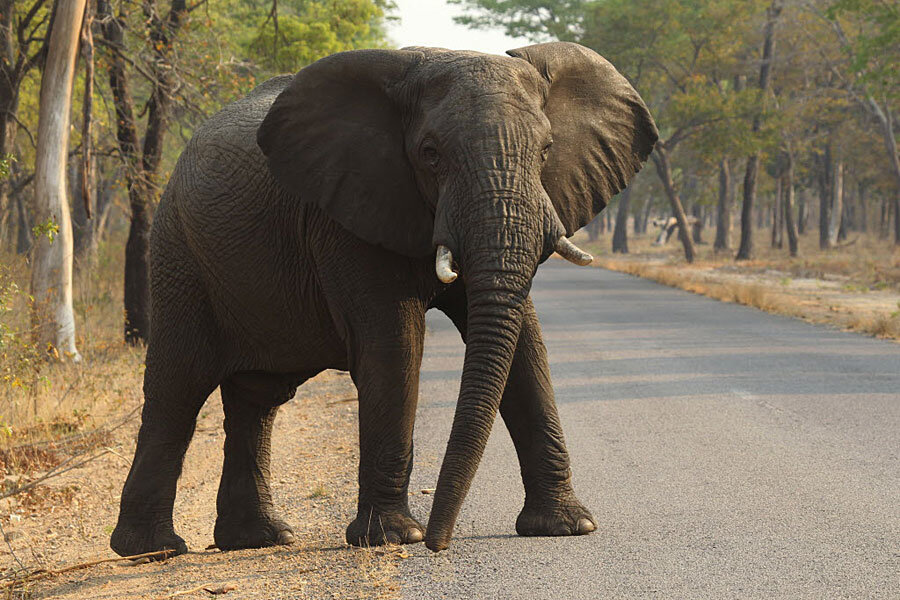From hypercarnivores to megafauna: How huge animals shaped their world
Loading...
Gigantic land animals, like elephants, wildebeest, the extinct mammoths and mastodons, play a significant role in shaping their ecosystems, according to a suite of studies released this week.
And their disappearance likewise has a great impact, according to one study published Monday in the journal Proceedings of the National Academy of Sciences.
Researchers looked at the changes in ecosystems after major megafauna, or large animal, extinctions in the Americas in the past 15,000 years, since humans arrived.
“Ecological studies have shown that if you pull out a top predator or a key herbivore today, you get dramatic change in the ecosystem,” study lead author and University of California Berkeley professor of integrative biology Anthony Barnosky said in a news release. “Our study makes it clear that in the past, such changes have lasted for thousands of years. These extinctions really do permanently change the dynamics. You can’t go back.”
These large animals can have a variety of impacts on their ecosystem.
When a carnivore disappears from the food chain, the balance is changed.
Huge herbivores prevent plants and trees from taking over a region. Without something snacking on it, a forest might take over fields. They also alter the soil nutrients where they feed, as they leave their waste behind – more on that particular impact later.
“You see the impact of defaunation today in Africa, where the removal of elephant populations has led to these shrubby, scraggly acacias filling the savanna landscape,” said co-author Charles Marshall, a professor of integrative biology and director of the UC Museum of Paleontology. “Africa today, with its elephant populations, seems to fit the model of North America with its mammoths and mastodons.”
Understanding these patterns could have huge implications for present-day animals.
But it might not be straightforward.
“It’s not a simple story, where if you pull out a big beast you see major changes in the landscape,” Dr. Barnosky said. “It’s actually dependent on how big a beast you pull out, and also how that beast interacts with the plants and animals in the area, and what other plants and animals are there. It depends on what the animal does for a living.”
While shrinking elephant populations in Africa today leave plants untamed, when the South American mastodon disappeared from the Pampas of Argentina, there was no significant change in the ecosystem. The authors suggest this was because the environment was less supportive of forest growth.
“This information could be useful to conservation biologists in pinpointing which types of ecosystems are likely to be affected by global climate change, and which would be most responsive to conservation and restoration efforts,” said co-author and UC Berkeley postdoctoral fellow Emily Lindsey.
Ancient carnivores kept humongous herbivores in check
Some 15,000 years ago herbivores, like the mammoth, mastodons and giant ground sloths were much larger than today’s biggest herbivores. With such size, and bigger populations, these ancient plant-eating giants might have devastated vegetation.
But in another paper published this week, Duke University scientists found that gigantic “hypercarnivores” kept the enormous vegetarians in check.
This study, also published in PNAS, found that these Pleistocene predators were about twice as large as modern-day wolves, lions, and hyenas, and they would hunt in packs.
"From the present day, it seems that big animals like elephants are immune to predation," study author V. Louise Roth said in a news release. "In fact, Pleistocene ecosystems were a lot more complex and predators could have had a larger impact."
But humans have eliminated many of those large predators, dramatically changing this dynamic.
Dropping nutrients around the world
With the extinction of enormous animals also comes the loss of anything they produce, including their feces.
And huge animal poop may be more important than it seems.
A third study finds that the world is suffering from a shortage of mega manure.
The extinct megafauna fertilized the soil well during their time on Earth, according to the paper published Monday, also in PNAS. The manure these animals produced helped spread nutrients around the world on land and in the sea.
"Previously, animals were not thought to play an important role in nutrient movement," study lead author Christopher Doughty, an ecologist at the University of Oxford, said in a news release. But that idea may just be a result of living during a time without those megafauna manures.
”This once was a world that had ten times more whales; twenty times more anadromous fish, like salmon; double the number of seabirds; and ten times more large herbivores – giant sloths and mastodons and mammoths," said Joe Roman, a whale expert and study author.
Between ancient herbivores, carnivores and their excrement the loss of megafauna can dramatically change an ecosystem.
“If we lose some of these big-bodied animals that are threatened with extinction today, we lose a lot more than those animals; we lose the entire ecosystems of which they are part,” Barnosky said. “We are moving into new territory in terms of what the planet will look like.”








